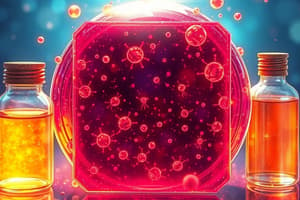Podcast
Questions and Answers
What is the primary purpose of isolating and cultivating viruses in a clinical context?
What is the primary purpose of isolating and cultivating viruses in a clinical context?
- To enhance virus stability outside the host
- To permanently eliminate the virus from the environment
- To genetically modify the virus
- For diagnosis and treatment options (correct)
Which of the following methods best describes how Western blot assays function?
Which of the following methods best describes how Western blot assays function?
- Viruses are visualized directly under an electron microscope
- Proteins are separated using a sodium dodecyl sulfate (SDS) process (correct)
- Antibodies are used to neutralize virus particles
- Cultured viruses are treated with UV light to enhance visibility
Which characteristic of naked viruses contributes to their ability to survive in the environment?
Which characteristic of naked viruses contributes to their ability to survive in the environment?
- They replicate faster inside host cells
- They are dependent on host cellular machinery for survival
- They are resistant to physical and chemical inactivation (correct)
- Their lipid envelopes protect them from drying
What type of sample is typically collected for diagnosing viral meningitis or encephalitis?
What type of sample is typically collected for diagnosing viral meningitis or encephalitis?
In the context of viral assays, what is the primary role of antigen capture assays?
In the context of viral assays, what is the primary role of antigen capture assays?
What factor significantly affects the preservation of virus infectivity during cultivation?
What factor significantly affects the preservation of virus infectivity during cultivation?
Which assay is known for its high specificity in confirming the presence of antiviral antibodies?
Which assay is known for its high specificity in confirming the presence of antiviral antibodies?
What is a common characteristic of enveloped viruses that affects their survival outside a host?
What is a common characteristic of enveloped viruses that affects their survival outside a host?
What is a primary disadvantage of using ELISA for viral detection?
What is a primary disadvantage of using ELISA for viral detection?
What characteristic makes PCR a preferable method for viral nucleic acid detection?
What characteristic makes PCR a preferable method for viral nucleic acid detection?
How does Reverse Transcriptase PCR (RT-PCR) differ from regular PCR?
How does Reverse Transcriptase PCR (RT-PCR) differ from regular PCR?
What is the purpose of a Southern blot in viral detection?
What is the purpose of a Southern blot in viral detection?
What is a significant limitation of using culture methods for studying viruses?
What is a significant limitation of using culture methods for studying viruses?
What is the main advantage of using ViroChip for viral detection?
What is the main advantage of using ViroChip for viral detection?
Why is automated PCR considered beneficial in viral detection?
Why is automated PCR considered beneficial in viral detection?
What distinguishes gel electrophoresis from other viral detection methods?
What distinguishes gel electrophoresis from other viral detection methods?
What is the main difference between rate zonal density gradient centrifugation and equilibrium (isopycnic) centrifugation?
What is the main difference between rate zonal density gradient centrifugation and equilibrium (isopycnic) centrifugation?
Which purification method is most similar to bacterial culture for isolating viruses?
Which purification method is most similar to bacterial culture for isolating viruses?
What type of gel electrophoresis is used to disrupt virions and analyze proteins?
What type of gel electrophoresis is used to disrupt virions and analyze proteins?
In the context of virus purification, what does the term 'pellet' refer to?
In the context of virus purification, what does the term 'pellet' refer to?
What method is commonly employed to convert RNA into free nucleotides during identification processes?
What method is commonly employed to convert RNA into free nucleotides during identification processes?
What is the purpose of using SDS in gel electrophoresis for viral analysis?
What is the purpose of using SDS in gel electrophoresis for viral analysis?
What characteristic feature distinguishes density gradient ultracentrifugation in viral particle purification?
What characteristic feature distinguishes density gradient ultracentrifugation in viral particle purification?
Which statement about limiting dilution of the original sample in virus purification is true?
Which statement about limiting dilution of the original sample in virus purification is true?
Which of the following best describes the process of obtaining biologically pure viruses?
Which of the following best describes the process of obtaining biologically pure viruses?
Flashcards are hidden until you start studying
Study Notes
ELISA and Viral Detection Methods
- ELISA is generally slow; detection of related viruses is challenging due to cross-reactivity among flaviviruses.
- High sensitivity but low specificity may lead to numerous false positives in antibody detection assays.
- Viral nucleic acid detection via PCR (Polymerase Chain Reaction) is cheap, fast, highly sensitive, and specific, yet can be contaminated.
- Reverse Transcriptase PCR (RT-PCR) is used for RNA detection; Southern and Northern blotting techniques for DNA and RNA respectively; sequencing provides detailed viral identification.
ViroChip Features
- ViroChip contains 36,000 sequences representing all known viral sequences as of December 2019.
- Each microarray element is converted into stripes organized by viral family.
- Stripes' hybridization intensity is represented in a linear scale; very specific for viral identification.
Comparison of Assays
- Titre values can vary significantly based on the assay used; only a small fraction of viral particles may actually replicate.
- In vivo, 1 in 100 assembled particles in a cell may be infective.
Virus Cultivation and Importance
- Cultivation is essential for virology research and production of reagents such as antivirals and antibodies.
- Certain viruses lack culture systems, requiring alternative methods for diagnosis and public health measures.
- Virus stability varies; enveloped viruses are sensitive to environmental conditions, while naked viruses like Norovirus can survive for years.
Clinical Sample Collection Methods
- Samples vary by infection type: throat washings for respiratory, fecal for enteric, CSF for meningitis, and blood for systemic infections.
- Samples should be refrigerated or frozen in buffered media for transport.
Viral Detection Techniques
- Direct visualization using electron microscopy allows family identification and confirmation via antibody specificity.
- Western blotting uses detergents to solubilize proteins; high specificity for antiviral antibodies.
Traditional and Modern Cultivation Techniques
- Chicken egg cultivation is dated but still used for some flu vaccines; inoculations can produce visible pocks.
- Mammalian cell cultures are preferred, utilizing primary cells, diploid, and continuous cell lines, including HeLa cells.
- Safety protocols require class II biohazard cabinets for handling viral cultures; class IV isolation for highly pathogenic viruses.
Organ-on-a-Chip Technology
- Organoids, mini organs using stem cells, assist in growing various viruses and studying host responses.
SARS Outbreak Case Study
- SARS outbreak began in November 2002, with a peak reported in April 2003, resulting in 5,327 cases and 349 deaths.
- Control measures included strict public health cooperation and monitoring, including identification of bats as a natural reservoir.
Viral Structure and Composition
- Definitions:
- Virion = virus particle
- Capsid = protein shell of genome
- Nucleocapsid = nucleic acid-protein assembly
- Envelope = lipid bilayer from host.
Energy Requirements for Viral Stability
- Viruses must balance stability to protect nucleic acid with the ability to release genetic material when targeting host cells.
Purification of Viral Particles
- Purification strategies include plaque purification, dilution, and generation from molecular clones.
- Cell disruption methods are crucial for isolating viral particles, often employing freeze-thaw cycles or homogenization techniques.
Centrifugation Techniques in Viral Research
- Various centrifugation methods are used to separate nucleic acids and proteins; key processes include density gradient ultracentrifugation for purifying viruses.
Identifying Viral Components
- SDS-PAGE allows for protein identification; mass spectrometry reveals protein abundance and modifications.
- Distinguishing DNA from RNA involves specific labeling techniques.
Icosahedral Structure in Viruses
- Icosahedral capsids use identical protein arrangements for maximum stability, containing 20 triangular faces.
- Examples include adenovirus and poliovirus, both having distinct structural arrangements that facilitate host interaction.
Triangulation in Virus Structure
- The triangulation number (T) helps describe the arrangement of proteins in icosahedral viruses, with varying sizes impacting assembly and structural integrity.
Studying That Suits You
Use AI to generate personalized quizzes and flashcards to suit your learning preferences.




